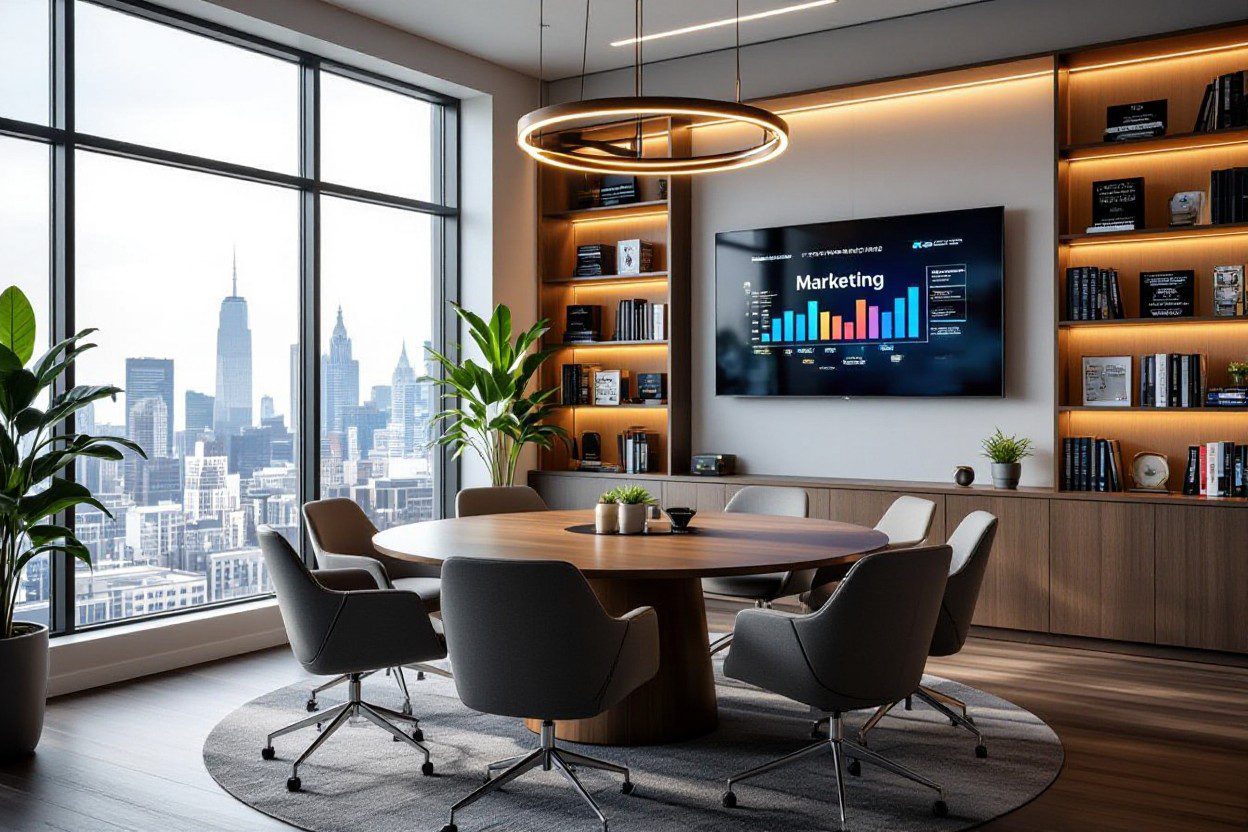Digital marketing agencies near you can amplify your brand by combining targeted SEO, paid ads, content strategy and analytics to drive measurable growth; you should evaluate their local case studies, communication style and measurement approach to ensure your goals are prioritized and your budget is maximized.


Understanding Digital Marketing
Key Components of Digital Marketing
You rely on SEO, PPC, content marketing, social media, email, and analytics to reach and convert customers. Organic search often drives over 50% of website traffic while paid search conversion rates average 3–4% across industries; content and social boost top-of-funnel reach and remarketing improves lifetime value. Use A/B testing and attribution data to shift budget toward channels where your cost per acquisition falls below your target LTV:CAC ratio.
Importance of Local SEO
Local searches shape foot traffic and sales: about 46% of Google queries show local intent and roughly 78% of local mobile searches lead to an offline purchase. You capture nearby buyers by optimizing your Google Business Profile, ensuring accurate NAP data, and targeting geo-modified keywords like “digital marketing agency near me” to appear in the Local Pack.
Improve visibility by adding services, photos, and weekly posts to your Google Business Profile, soliciting and responding to reviews within 24–48 hours, and implementing LocalBusiness schema markup. Build citations on industry directories, secure backlinks from local partners, and track map-pack rankings; focused local optimization often produces double-digit lifts in calls and direction requests.


Benefits of Hiring a Local Digital Marketing Agency
Personalized Services
You get campaigns tailored to your business: budget allocation, messaging, and channel mix adjusted to your customer profile. Local agencies typically offer weekly or biweekly strategy calls and can pivot ads or content within 48 hours; that flexibility helped a neighborhood retailer reallocate 30% of ad spend to high-performing campaigns, raising conversions by 25% in two months.
Knowledge of Local Market Trends
You benefit because the agency tracks area-specific KPIs like neighborhood search volume, peak foot-traffic times, and regional keywords. Using localized analytics and past campaign data, they identify high-value ZIP codes and audience segments, often cutting wasted impressions by up to 40% and increasing store visits during target hours.
Local seasonality, competitor openings, and event calendars let you time promos and content precisely: agencies map city festival dates, university semesters, and commuter patterns to schedule ads and push notifications. For example, targeting nearby office ZIP codes before 8:30 AM increased mobile orders by 18% for a café, showing how hyperlocal timing and messaging convert into measurable revenue.
Services Offered by Digital Marketing Agencies
You’ll find agencies package services like SEO, PPC, social media, content marketing, email campaigns, CRO, analytics and local listings management so your channels work together; most agencies manage monthly budgets from a few hundred to $10,000+ and provide KPIs (traffic, leads, CPA) and dashboards so you can track ROI in real time.
Search Engine Optimization (SEO)
You’ll get on-page optimization, technical fixes (site speed, crawlability), schema and structured data, content strategy and backlink acquisition; typical outcomes include organic traffic increases of 30–150% over 6–12 months, and local SEO tactics like Google Business Profile optimization can boost map-pack visibility for searches within a 5–10 mile radius.
Social Media Marketing
You’ll receive platform-specific strategies for Facebook, Instagram, TikTok and LinkedIn combining organic content, paid ads and community management; paid campaigns often see CPCs ranging $0.20–$2.00 and conversion rates of 1–3%, while targeted creative and A/B tests drive engagement and lower CPA.
You should expect a content calendar, influencer outreach, retargeting and audience segmentation to be part of the plan; agencies use UTM-tagged links, lookalike audiences and dynamic ads to scale—one DTC client doubled monthly revenue and achieved a 4:1 ROAS after three months of iterative creative testing and pixel-based retargeting.
How to Choose the Right Digital Marketing Agency
Evaluating Experience and Expertise
Scan an agency’s track record: you should see 3–5+ years, Google Partner and Meta certifications, plus case experience in your industry. Look for specialists in channels you need—SEO, paid search, social ads, email—and for team sizes that match project scale (2–5 for SMBs, 10+ for enterprise). Ask for KPIs they routinely hit, such as 20–50% organic traffic growth or a 30% reduction in CPA over six months.
Assessing Portfolios and Client Testimonials
Review case studies that include clear before/after KPIs: organic traffic, leads per month, CPA, and revenue impact. You should see dated results, scope of work, channel mix, and attribution methods. Prefer portfolios with 3–5 detailed studies relevant to your niche and contactable client references to validate claims rather than generic screenshots.
Dig deeper by asking for analytics exports, campaign timelines, and test/learn cycles; you can spot cookie‑cutter work when metrics lack context. Seek agencies with client retention over 12 months and published conversion lifts of 10–30%. Verify sample dashboards, request reference calls, and propose a short pilot with measurable KPIs before signing a long-term contract.
Cost Considerations for Digital Marketing Services
Agency fees vary widely: expect monthly retainers from $1,500–$10,000+, hourly rates of $75–$250, and project fees from $5,000–$50,000 depending on scope. Ad spend is usually billed separately—search CPC often runs $1–$2, display $0.20–$0.50, and CPA benchmarks can range $50–$200 by industry. You should factor onboarding, reporting, creative production and platform costs into total spend, and aim for ROI targets like 3x ROAS for e-commerce to judge value.
Pricing Models Explained
Hourly billing gives flexibility for small tasks, retainers cover ongoing strategy and execution, and project fees suit one-off launches; agencies sometimes charge 10–20% of ad spend or performance-based fees tied to leads or sales. You might prefer a retainer plus percentage for scalability—example: $3,000/month retainer + 12% of ad spend for a $20,000 media budget equals $5,400 total. Clear scopes and deliverables prevent scope creep.
Budgeting for Digital Marketing
Many businesses allocate 7–12% of revenue to marketing, startups often 12–20%; for instance, $500,000 revenue at 7% equals $35,000 annually (~$2,900/month). Separate funds for ad spend and agency fees—if you plan $3,000/month to an agency, add a $6,000/month media budget for paid channels. You should set KPIs (CPA, ROAS) tied to those allocations so each dollar maps to measurable outcomes.
Dive deeper by prioritizing channels based on LTV:CAC—if your average customer LTV is $400 and target CAC is $80, you can spend up to $80 to acquire a customer profitably. Reserve 10–20% of the budget for tests (new creatives, channels), run 30–60 day experiments, then reallocate to top performers; use cohort analysis and monthly reporting to shift spend toward channels hitting target CPA or ROAS.
Future Trends in Digital Marketing
Expect hyper-personalization, privacy-first measurement, creator-driven commerce, and AI-enabled workflows to reshape your strategy; integrated partners such as VaynerMedia : Integrated Strategy, Creative and Media Agency will be relied on for cross-channel orchestration. TikTok reached 1 billion monthly users in 2021 and platforms keep shifting ad formats toward shoppable, short-form experiences that demand faster creative cycles and tighter measurement.
The Rise of AI and Automation
Generative models like GPT and diffusion engines now produce personalized subject lines, ad copy, and rapid creative variants, while programmatic platforms automate bidding and audience optimization so you move from periodic A/B tests to continuous multivariate experimentation; expect AI to power dynamic creative optimization, predictive LTV scoring, and automated media allocation across channels.
Increased Focus on Video Content
Short-form vertical video and shoppable clips should be core to your funnel: YouTube has over 2 billion logged-in monthly users and TikTok surpassed 1 billion monthly active users in 2021, driving discovery and lower CPMs for native, native-feeling content.
Prioritize repurposing long-form into 15–60 second hooks, add captions for silent autoplay, and partner with creators for authenticity—brands like Duolingo and Gymshark scaled reach through creator-first TikTok strategies. Track watch time, view-through rate and conversion lift by format so you can allocate spend to the video lengths and platforms that actually drive revenue.
To wrap up
Considering all points, you should choose a digital marketing agency near you that offers local market knowledge, clear ROI metrics, tailored strategies, transparent reporting, and ongoing optimization to grow your visibility and conversions.
FAQ
Q: How do I find a reliable “digital marketing agency near me” that fits my business?
A: Look for agencies with local experience and verifiable results: review portfolios and case studies for businesses like yours, check Google My Business and third-party reviews, and ask for client references you can contact. Verify technical skills (local SEO, PPC, analytics), industry specialization, and communication practices. Request a discovery meeting to assess their strategic approach, sample audit or plan, reporting cadence, team members who will work on your account, and how they measure success. Prefer agencies that provide transparent pricing, clear deliverables, and a written scope of work or contract.
Q: What services should a local digital marketing agency provide for small or brick-and-mortar businesses?
A: Core services include local SEO (Google Business Profile optimization, local citations, schema markup), website optimization for conversions and mobile, paid search and local display ads (geo-targeted campaigns), social media management and localized social ads, content marketing tailored to local audiences, email marketing, and online reputation management. They should set up tracking (Google Analytics, conversion tracking, call tracking) and provide regular reports with actionable insights. For in-person businesses, expect emphasis on driving phone calls, appointment bookings, foot traffic, and local reviews rather than only site visits.
Q: How much does hiring a digital marketing agency near me typically cost, and how will I know if it’s delivering ROI?
A: Pricing models vary: hourly consulting ($75–$200+/hr), monthly retainers for ongoing services ($500–$7,000+/month depending on scope), project fees for site builds or campaigns ($1,000–$30,000+), and performance-based or hybrid models. Set measurable goals up front (leads per month, cost per lead, conversion rate, revenue from marketing) and require regular reporting on those KPIs. Short-term channels like PPC can show results in days to weeks; SEO and content take 3–6 months to gain traction. Calculate ROI by comparing marketing-driven revenue or lifetime value of acquired customers against total marketing spend, and require the agency to run A/B tests and optimize campaigns to improve those metrics over time.

